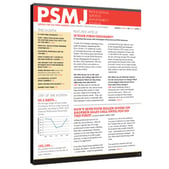You can’t let project managers know the direct labor charged to their projects. They might use this information to figure out the salaries of their coworkers. Who knows what chaos would ensue!
Ever hear this? Practice this? Hiding direct labor charges is a bad idea. Here’s why.
When they do not know the direct labor charges, project managers do not know either the budgeted or actual profitability of a project…and you need all the help you can get to improve your firm’s profitability.
When they are armed with complete information, project managers become a key resource for improving profits—it’s not just the job of the partners!
PROFITABLE PROJECTS
The profitability of a project is defined precisely by the equation:
Pp = 1 – ( Mp / Mb) = Profit as a fraction of project net revenue
Where Mp is the project’s net revenue multiplier and Mb is the firm’s breakeven net revenue multiplier.
 The latter can be easily calculated by subtracting the firm’s profit from its net revenue and dividing the result by all the direct salaries charged to projects; the former is calculated by dividing the project’s actual net revenue by the direct labor charged to the project.
The latter can be easily calculated by subtracting the firm’s profit from its net revenue and dividing the result by all the direct salaries charged to projects; the former is calculated by dividing the project’s actual net revenue by the direct labor charged to the project.
You can hide the firm’s entire direct salary number, but if you don’t give the project manager the direct salaries charged to their project, they cannot know their profitability.
In turn, this kind of calculation allows you to calculate profitability of classes of projects: electrical subdesign, structural engineering, site selection etc., allowing you to make strategic decisions about focusing marketing efforts, and in some cases, partly or totally phasing out some unprofitable or poorly profitable areas.
ARMED WITH INFORMATION
Armed with this tool, project managers can devise ways to budget (and price) projects for higher profitability. This is extremely useful when dealing with Lump Sum projects, and is also applicable to time and materials projects.
Management can identify (and reward) project managers who are adept at maximizing project profits. These gurus can then teach other project managers their best practices. And guess what? The sum of all project profits is the total profit of your firm.
Besides, if you think that your employees do not have some idea of the salaries of their co-workers, you are kidding yourself.
About the Author: Brian Flynn, P.E., BCEE, is PSMJ Consultant and Instructor, with more than 40 years of engineering and environmental industry experience. This includes being one of the original founding partners of global environmental consulting firm ERM Group and serving as President of ERM-Southwest in Houston, Texas. Reach him at BFlynn@PSMJ.com
 This article is featured in PSMJ's September 2017 newsletter, Professional Services Management Journal (PSMJ). In today’s fast-moving information overload world, it seems that there is industry-related content everywhere you look, with some nuggets of advice on how you can be more successful. PSMJ’s carefully-curated content ensures that you are not getting generic filler, hypothetical fluff, or anything but proven battle-tested advice. Check out a free copy available at the link below.
This article is featured in PSMJ's September 2017 newsletter, Professional Services Management Journal (PSMJ). In today’s fast-moving information overload world, it seems that there is industry-related content everywhere you look, with some nuggets of advice on how you can be more successful. PSMJ’s carefully-curated content ensures that you are not getting generic filler, hypothetical fluff, or anything but proven battle-tested advice. Check out a free copy available at the link below.



